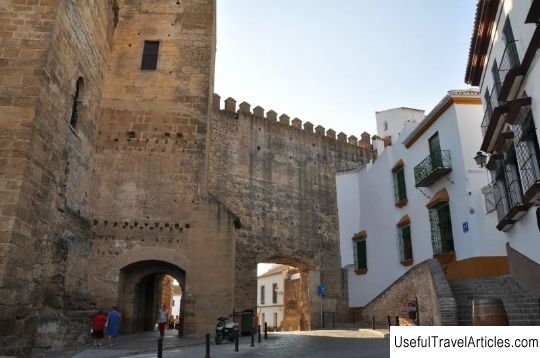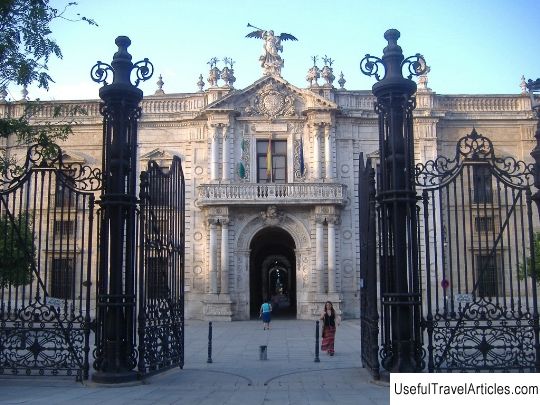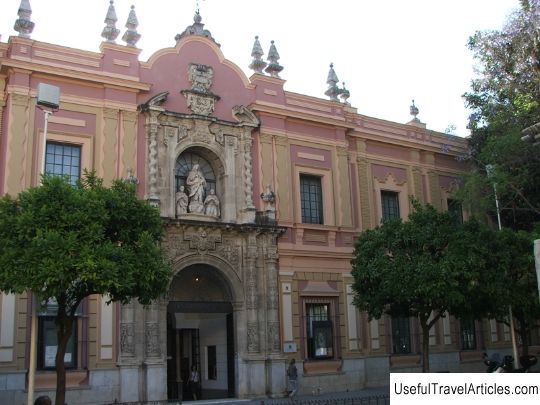Seville city walls (Murallas de Sevilla) description and photos - Spain: Seville

Seville City Walls (Murallas de Sevilla) description and photos - Spain: Seville. Detailed information about the attraction. Description, photographs and a map showing the nearest significant objects. The title in English is Murallas de Sevilla. Photo and descriptionOne of the interesting historical places that attracts tourists and visitors to Seville is the ancient city walls that surrounded the old city and partially preserved to this day. The city walls were erected as defensive fortifications, and their construction continued throughout the history of Seville - during the Visigoths, the Arab invasion and the rule of the Castilian kings. It is known that the city walls included eighteen gates that opened access to the city, but to this day only four of them have survived - these are the Macarena, Cordoba, Aceite and Alcazar gates. The construction of the walls began in the era of the Roman Empire, during the reign of Julius Caesar, between 65 and 68. AD The walls were built on the site of the old wooden palisade that surrounded the city. In 844, during the reign of the Arab Caliphate, the city and the surrounding walls were destroyed by the Vikings, after which they were rebuilt by order of Emir Abderrahman II. After that, the city walls were destroyed several more times and rebuilt. In the 11-12 centuries, the city walls were expanded and significantly fortified. By the time the city was conquered by the Christian king Ferdinando in 1248, the city walls included 166 towers and 13 gates. During the reign of King Charles I, the walls, towers, and also the entrance gates were overhauled. Over time, the city walls lost their defensive functions, and began to be used mainly for flood protection during the Guadalquivir flood, as well as in commercial purposes, because a special fee was introduced for entering the city. the city and the surrounding walls were destroyed by the Vikings, after which they were rebuilt by order of Emir Abderrahman II. After that, the city walls were destroyed several more times and rebuilt. In the 11-12 centuries, the city walls were expanded and significantly fortified. By the time the city was conquered by the Christian king Ferdinando in 1248, the city walls included 166 towers and 13 gates. During the reign of King Charles I, the walls, towers, and also the entrance gates were overhauled.Over time, the city walls lost their defensive functions, and began to be used mainly for flood protection during the Guadalquivir flood, as well as in commercial purposes, because a special fee was introduced for entering the city. the city and the surrounding walls were destroyed by the Vikings, after which they were rebuilt by order of Emir Abderrahman II. After that, the city walls were destroyed several times and rebuilt again. In the 11-12 centuries, the city walls were expanded and significantly fortified. By the time the city was conquered by the Christian king Ferdinando in 1248, the city walls included 166 towers and 13 gates. During the reign of King Charles I, the walls, towers, and also the entrance gates were overhauled.Over time, the city walls lost their defensive functions, and began to be used mainly for flood protection during the Guadalquivir flood, as well as in commercial purposes, because a special fee was introduced for entering the city. After that, the city walls were destroyed several more times and rebuilt. In the 11-12 centuries, the city walls were expanded and significantly fortified. By the time the city was conquered by the Christian king Ferdinando in 1248, the city walls included 166 towers and 13 gates. During the reign of King Charles I, the walls, towers, and also the entrance gates were overhauled.Over time, the city walls lost their defensive functions, and began to be used mainly for flood protection during the Guadalquivir flood, as well as in commercial purposes, because a special fee was introduced for entering the city. After that, the city walls were destroyed several more times and rebuilt. In the 11-12 centuries, the city walls were expanded and significantly fortified. By the time the city was conquered by the Christian king Ferdinando in 1248, the city walls included 166 towers and 13 gates. During the reign of King Charles I, the walls, towers and entrance gates were overhauled.Over time, the city walls lost their defensive functions, and began to be used mainly for flood protection during the Guadalquivir flood, as well as in commercial purposes, because a special fee was introduced for entering the city. By the time the city was conquered by the Christian king Ferdinando in 1248, the city walls included 166 towers and 13 gates. During the reign of King Charles I, the walls, towers and entrance gates were overhauled.Over time, the city walls lost their defensive functions, and began to be used mainly for flood protection during the Guadalquivir flood, as well as in commercial purposes, because a special fee was introduced for entering the city. By the time the city was conquered by the Christian king Ferdinando in 1248, the city walls included 166 towers and 13 gates. During the reign of King Charles I, the walls, towers, and also the entrance gates were overhauled.Over time, the city walls lost their defensive functions, and began to be used mainly for flood protection during the Guadalquivir flood, as well as in commercial purposes, because a special fee was introduced for entering the city. a special fee was introduced for entering the city. a special fee was introduced for entering the city.      We also recommend reading Elounda description and photos - Greece: Crete Topic: Seville city walls (Murallas de Sevilla) description and photos - Spain: Seville. |




